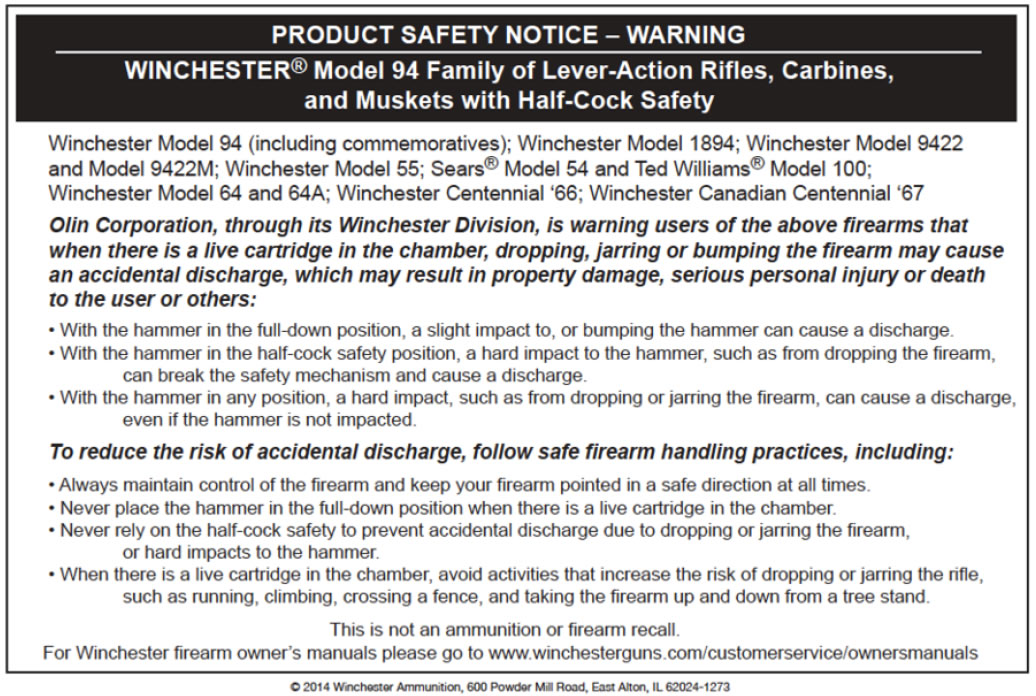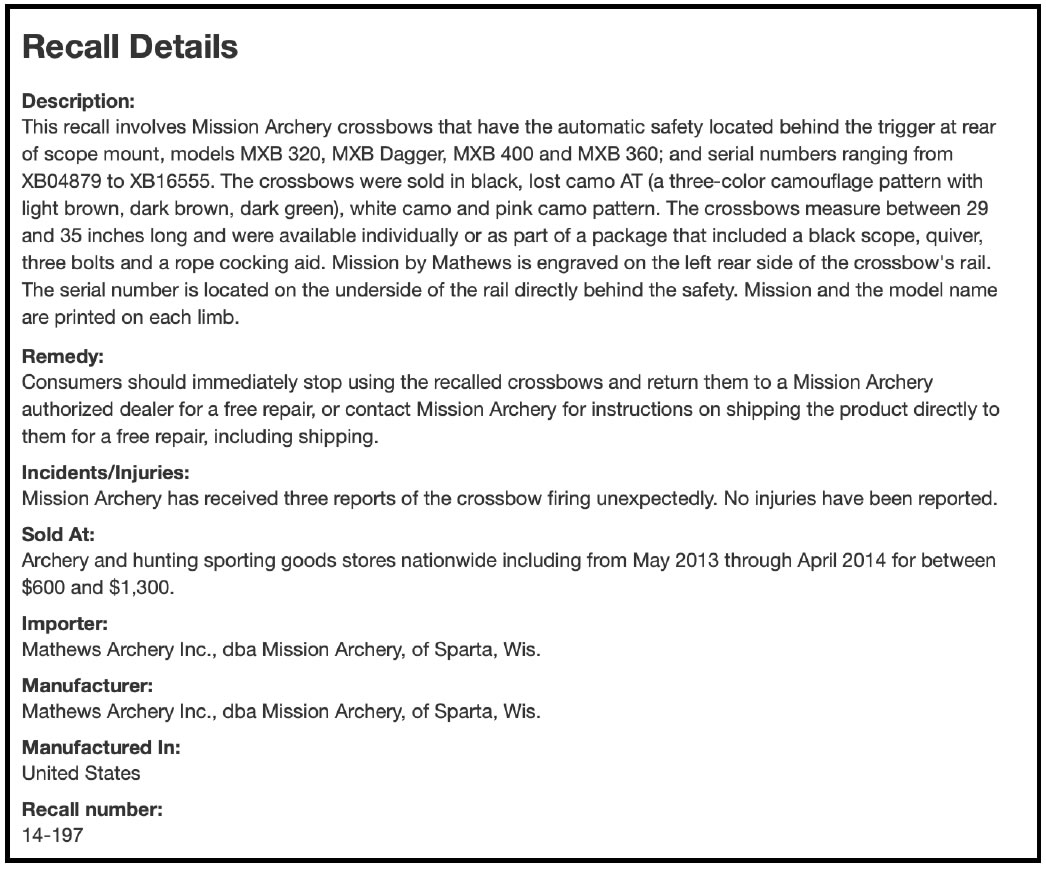Regulated vs. Unregulated Recalls
In order to understand the importance of government involvement in manufacturer recalls, it is helpful to review an example of the differences between an unsupervised voluntary gun recall and a recall carried out with the oversight of the Consumer Product Safety Commission.
The Olin Corporation, which manufactured Winchester rifles that were prone to fire when dropped, defended its popular “Model 94” hunting rifles in personal injury cases for several decades, arguing that there was no proof of a manufacturing defect. Yet in 2014, Olin issued the following safety warning.43

Although the Model 94 was discontinued in 2006, more than 6.5 million of the rifles had previously been manufactured and many are still in use, primarily for hunting deer.44 The safety warning represents an acknowledgement that the rifle can, in fact, fire when dropped, without a trigger pull, even when the gun’s user believes that the rifle is not fully cocked.
Certainly, each of the circumstances described halfway through the safety warning are foreseeable in the context of hunting. The company acknowledges the potential for “serious personal injury or death to the user or others.” Nevertheless, there is no recall and no instruction not to use the weapon because of the defect. Instead, users are instructed to follow the types of basic safety procedures that one should implement with respect to any gun. Users are simply told to avoid the circumstances in which injuries might occur from the consequences of the defect.
The deficiencies in this Safety Notice are best understood when compared with a notice issued under CPSC standards.45 A close analogy to a gun recall is a 2014 crossbow46 recall involving a defect in which the recalled crossbow could apparently fire an arrow without a trigger pull.47 The recall notice for certain Mission Archery crossbows clearly states the potential hazard without limiting language: “The crossbow can fire an arrow unexpectedly without the trigger being pulled, posing an injury hazard to the user and to bystanders.”48 More specific information is then offered (see form on following page).
Like the Winchester rifle recall safety warning shown previously, this notice was issued in 2014 to address a dangerous defect in which a projectile may be unintentionally fired. It is for a product, a crossbow, with a similar range of retail prices to the Winchester rifle. Although there are only three reports of the crossbow’s defect, without reported injuries, the notice provides for a recall rather than a “safety warning.”
Importantly, the notice warns consumers to stop using the product “immediately.” In short, on the basis that injuries and deaths from the defect are likely and foreseeable, the crossbow recall provides a meaningful consumer remedy rather than instructions for the consumer to use care to avoid manifestation of the defect.

Not surprisingly, given the potency of the crossbow recall notice, it generated a participation rate above 60 percent, meaning that more than 60 percent of the affected crossbows were made safe by repair or replacement.49 This stands in stark contrast to the negligible participation rates in the Remington and Taurus class action recall programs described earlier.50
The existence of dozens of voluntary gun recalls and defect-related safety warnings illustrates that guns, like any manufactured consumer product, are vulnerable to defects. Indeed, those defects are likely to present serious public safety problems that in many cases, exceed the safety risks associated with other consumer product defects. Yet, the unsupervised voluntary recall practices of the gun industry lack the rigor of those overseen by the CPSC. The gun manufacturers’ voluntary recall notices identified by the Violence Policy Center:
• are inconsistent about the level of warning and severity of potential injury they convey;
• fail to provide information about the number of customer complaints, injuries, and deaths associated with the defect;
• undermine their messages with caveats and exculpatory language;
• often convey a warning rather than an effective remedy;
• often are issued long after a problem became known to the manufacturer;
• usually fail to offer to pay the costs of shipping associated with completing recall work; and,
• are not consistently publicized according to best practices.
Under these circumstances, it is likely that such recalls, despite the high level of danger associated with the defects at issue, are less effective than those that are properly supervised by the Consumer Product Safety Commission, an independent government agency.
Back to Table of Contents
Next – Summary: The Consequences Of Exempting Guns From Safety Regulations
43 Product Safety Notice – Warning, Winchester Ammunition (2014), https://www.winchesterint.com/services/ownermanuel/PDF/carabine/levier/MODEL%2094.pdf. See Trask v. Olin Corp., Civil Action No. 12-340 (W.D. Pa. Mar. 28, 2016) describing the issuance of various safety notices over time.
44 Charles M. Robinson III, “The Winchester 94 Gone With the Wind,” www.historynet.com (June 2007), https://www.historynet.com/winchester-94-gone-wind.htm.
45 Hundreds of examples of CPSC supervised recall notices can be found on its website at https://www.cpsc.gov/Recalls/.
46 Modern crossbows are based on ancient weapons that use a trigger to release an arrow, often with great force. Crossbow hunting is an activity in which a crossbow is used to hunt game, such as deer. According to the National Rifle Association’s American Hunter magazine, “Modern crossbows are fast, accurate, and plenty powerful enough to cleanly take the largest big-game animals in North America.” Bob Robb, “12 Crossbow Do’s and 3 Don’ts,” February 21, 2013), https://www.americanhunter.org/articles/2013/2/21/12-crossbow-dos-and-3-donts/.
47 “Mission Archery Recalls Crossbows Due to Injury Hazard; Can Fire Unexpectedly,” (CPSC Recall No. 14-197, June 13, 2014), https://www.cpsc.gov/Recalls/2014/mission-archery-recalls-crossbows.
48 “Mission Archery Recalls Crossbows Due to Injury Hazard; Can Fire Unexpectedly,” (CPSC Recall No. 14-197, June 13, 2014), https://www.cpsc.gov/Recalls/2014/mission-archery-recalls-crossbows. A clear and concise statement of the hazard without limiting language is a hallmark of CPSC recall notices (15 CFR § 1115.27(f)). See https://www.cpsc.gov/Recalls/.
49 Recall participation rate for Recall No. 14-197 received in response to a FOIA request by memo from the CPSC dated February 13, 2020, in files of Violence Policy Center.
50 See Notes 8 and 19, supra.






